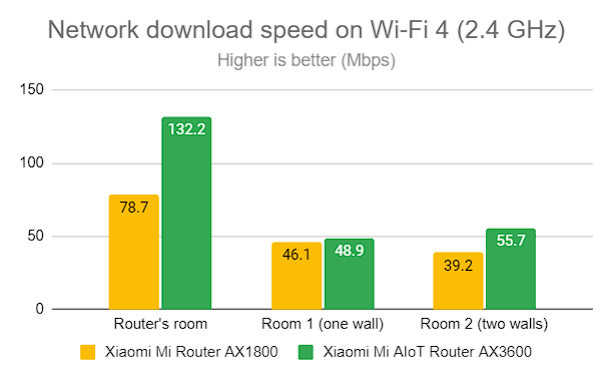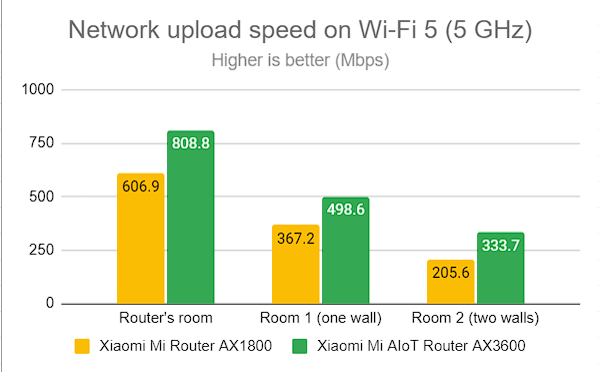
Wireless network performance
The apartment where I review the routers we receive for testing is set up similarly to the diagram below. As you can see, I’ve placed the Xiaomi Mi AIoT Router AX3600 in a central position to provide good coverage in all the rooms where I tend to spend most of my time.

The apartment in which I tested Xiaomi Mi AIoT Router AX3600
I evaluated the quality of the wireless network managed by Xiaomi Mi AIoT Router AX3600 through measurements made in three different places:
- I record the maximum speeds in the room where the router is placed.
- Room 1 - is separated by one wall from the router. The wireless signal and the Wi-Fi speed I get are lower here.
- Room 2 - is separated from the router by two walls absorbing the wireless signal. Also, the wall between Room 1 and Room 2 is twice as thick as the one between the router’s room and Room 1. Because of that, this room is a challenge for all the routers I review.
I made all my measurements using a brand new laptop that works great on Wi-Fi 6 networks, using Windows 11 and the latest drivers and operating system updates.
To get a better understanding of how this router performs, I’ve compared it with its more affordable brother: Xiaomi Mi Router AX1800. While they target different audiences, the comparison will give you a better perspective on what you get from Xiaomi Mi AIoT Router AX3600.
How the Xiaomi Mi AIoT Router AX3600 performs on the 2.4 GHz band
I always start my analysis by measuring the signal strength using NetSpot. When using the Wi-Fi 4 standard, this router delivered good signal strength in all the rooms of my apartment.

Signal strength on Wi-Fi 4 (2.4 GHz band)
When I switched to the Wi-Fi 6 standard on the 2.4 GHz band, the signal strength lowered slightly, but without becoming troublesome.

Signal strength on Wi-Fi 6 (2.4 GHz band)
I moved on to the SpeedTest app and used it to measure the maximum speed you get when transferring data to and from the internet on the 2.4 GHz band. The download speed offered by Xiaomi Mi AIoT Router AX3600 was excellent in the rooms closest to the router and rather disappointing in Room 2.

SpeedTest - The download speed on Wi-Fi 4 (2.4 GHz)
When measuring the upload speed, I noticed a decrease in all rooms. Also, in Room 2, Xiaomi Mi AIoT Router AX3600 couldn’t deliver a steady throughput, just like its smaller brother.

SpeedTest - The upload speed on Wi-Fi 4 (2.4 GHz)
When switching to the Wi-Fi 6 standard on the 2.4 GHz band, the downloads were generally faster than when using Wi-Fi 4.

SpeedTest - The download speed on Wi-Fi 6 (2.4 GHz)
The same was true when measuring the upload speed. However, Room 2 remained problematic, even though the situation improved compared to using the Wi-Fi 4 standard.

SpeedTest - The upload speed on Wi-Fi 6 (2.4 GHz)
For the next set of measurements, I used the PassMark Performance test to transfer data between two computers connected to the network. I was on the 2.4 GHz band with the Wi-Fi 4 standard turned on. Downloads were pretty fast in all rooms. However, other AX3600 routers can deliver more than the numbers you see in the chart below.

Network Wi-Fi downloads on Wi-Fi 4 (2.4 GHz)
When measuring the upload speed, things looked okay except for Room 2. In this test, Xiaomi Mi AIoT Router AX3600 managed to finish a network transfer but at a very low speed.

Network Wi-Fi uploads on Wi-Fi 4 (2.4 GHz)
When switching to the Wi-Fi 6 standard on the 2.4 GHz band, downloads were faster in most rooms.

Network Wi-Fi downloads on Wi-Fi 6 (2.4 GHz)
Uploads were generally slower than the downloads. Also, Room 2 proved to be a problem once again.

Network Wi-Fi uploads on Wi-Fi 6 (2.4 GHz)
My measurements have shown that Xiaomi Mi AIoT Router AX3600 doesn’t offer a large coverage area on the 2.4 GHz band. Also, this router won’t break any speed records on this frequency band, even though it is a lot faster than its smaller brother, Xiaomi Mi Router AX1800.
How the Xiaomi Mi AIoT Router AX3600 performs on the 5 GHz band
I switched to the 5 GHz band, and I started by measuring the signal strength with NetSpot. When using the Wi-Fi 5 standard, the signal strength was within normal parameters in all the rooms of my apartment.

Signal strength on Wi-Fi 5 (5 GHz band)
As you can see below, the signal strength lowered a bit when switching to Wi-Fi 6 on the 5 GHz band.

Signal strength on Wi-Fi 6 (5 GHz band)
I switched to the SpeedTest app. When using the Wi-Fi 5 standard, I enjoyed super fast downloads in all the rooms of my apartment, including the infamous Room 2.

SpeedTest - The download speed on Wi-Fi 5 (5 GHz)
Uploads were fast too, sometimes by a significant margin, compared to the Xiaomi Mi Router AX1800.

SpeedTest - The upload speed on Wi-Fi 5 (5 GHz)
Moving on to the Wi-Fi 6 standard on the 5 GHz band, downloads improved even further in the entire apartment.

SpeedTest - The download speed on Wi-Fi 6 (5 GHz)
The upload speeds delivered by the Xiaomi Mi AIoT Router AX3600 were very fast everywhere.

SpeedTest - The upload speed on Wi-Fi 6 (5 GHz)
For the next set of measurements, I used the PassMark Performance test to transfer data between two computers connected to the network. When using the Wi-Fi 5 standard, I measured some impressive numbers, especially in the room where the router was placed.

Network Wi-Fi downloads on Wi-Fi 5 (5 GHz)
The same was true for the uploads, even though they were slightly slower than the downloads.

Network Wi-Fi uploads on Wi-Fi 5 (5 GHz)
The Wi-Fi 6 performance was brilliant in the whole apartment. Even in Room 2, I’ve managed to get impressive results from Xiaomi Mi AIoT Router AX3600.

Network Wi-Fi downloads on Wi-Fi 6 (5 GHz)
Uploads were super-fast, too, absolutely everywhere.

Network Wi-Fi uploads on Wi-Fi 6 (5 GHz)
Xiaomi Mi AIoT Router AX3600 performs brilliantly on the 5 GHz band, both when using Wi-Fi 5 and Wi-Fi 6. However, Wi-Fi 6 does unlock this router's maximum potential, and you should be using this standard instead of the older one.
Wired network performance
Let’s evaluate the performance you get when using Ethernet network connections. My internet connection offers a maximum of 1 Gbps for the download speed and 800 Mbps for the upload. When using SpeedTest, Xiaomi Mi AIoT Router AX3600 reached the maximum potential of our internet connection: 928.44 Mbps for the download and 810.52 Mbps for the upload. I wish my internet service provider offered 1 Gbps uploads too so that I can better differentiate the routers I review.

SpeedTest on wired connections
Xiaomi Mi AIoT Router AX3600 has no problem handling 1 Gbps Ethernet connections.
Extra features
The firmware on the Xiaomi Mi AIoT Router AX3600 is less complex than on competing routers from other brands. For a router in its price range (100 to 120 USD) this is a downside because other brands deliver more features. With that being said, here’s what you get in terms of advanced features:
- Wi-Fi Optimization exists only in the Mi WiFi mobile app, not in the router’s web interface. It scans the signal strength of your network and the quality of your connection, and it improves the router’s settings. This should be added as a standard feature to the router’s firmware.
- Firewall - another mobile-only feature that makes it easy to evaluate the security of your network, set up blocklists for unwanted guests, and improve the password strength and WiFi security.
- IPv6 - the router can connect to the internet using IPv6 addresses, use IPv6 DNS servers, and assign IPv6 addresses to the clients connected to its network.
- QoS - an intelligent Quality of Service bandwidth allocation algorithm that prioritizes network traffic based on its type (gaming, web browsing, video, etc.). Unfortunately, it is designed to work only for 50 Mbps internet connections, rendering it unusable for people with fast internet connectivity of 100 Mbps and above.
- DDNS - enables you to connect to the router from the internet, even if your internet provider assigns you a dynamic public IP address. Xiaomi Mi AIoT Router AX3600 can use the following DDNS services: Oray DDNS, PubYun, DynDNS, and No-IP.
- VPN - the router can connect to VPN services using the PPTP and L2TP protocols, but it cannot function as a VPN server. You also set which services or devices can use VPN traffic. In contrast, many competing routers can be set to work as VPN servers too.
- Guest Wi-Fi - can be enabled only from the Mi WiFi app, not from the router’s firmware. Also, you can turn on only one guest network, and you can’t set the band it uses, only its name, password, and encryption.
- Mesh Wi-Fi - you can add the router as a node in a mesh Wi-Fi network composed of other Xiaomi wireless routers. It is a valuable feature when you need to increase the coverage of your Wi-Fi network.
- AIoT Intelligent Antenna Automatic Scan - automatically discovers Xiaomi Mi smart devices that have not been initialized and quickly connects them to the network through the Mi Home App.

AIoT Intelligent Antenna Automatic Scan
What is your opinion about the Xiaomi Mi AIoT Router AX3600 router?
You’ve arrived at the end of this review, and by now, you should know whether you want this router or not. Before leaving, tell me what you think: Do you like what the Mi AIoT Router AX3600 offers? Also, if you already own it, what has been your experience with it? Comment below, and let’s discuss.


 28.04.2022
28.04.2022 


